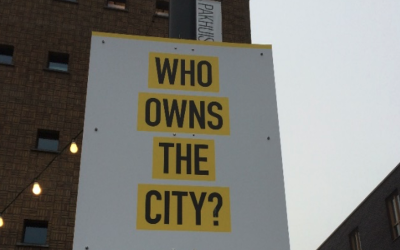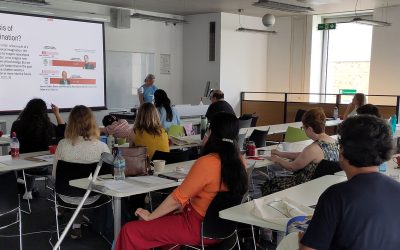Written by Dr Paul Symonds
Mobilities is a subject area that encapsulates a range of topics that are grouped by movement. In a post-modern world, for example, this movement includes people, information, culture (Urry, 2007), and heritage (Lo Iacono, 2018).Whole societies as well as individuals are on the move and mobile.
Mobilities though, also includes how we move in everyday experiences and in my recent PhD research, I combined mobilities and what is known as ‘wayfinding’. Wayfinding I hear you ask? What on earth is that?
Wayfinding in short, is how we get between A and B. You will yourself experience wayfinding on an almost daily basis. You might have to find your way through an airport, the way to a specific store in a city centre, to the toilet (restroom) if you are in a pub. Even when commuting and using a familiar route, a traffic accident can mean that you have to find your way on a new route. We are always wayfinding!
So when first thinking about wayfinding you might think about:
- directional signage
- the design of space
- technology
- human guiders (such as at sports events)
The vast majority of research on wayfinding, to date, tends to focus on psychology and wayfinding, with the focus on how we, as individuals, manage to get from A to B. In truth though the practice of wayfinding is, I realised, largely based not on our own actions and behaviour but on others! Those others include the other people we wayfind with or alongside, the signage makers, the owners of the spaces we find our way through, the councils and governments who manage many routes (think of rural paths and access and provision of passports for example).
For this reason, in my research, I stepped away from this over-reliance of psychology as a tool for analysing wayfinding (but not dismissing it in my research) and this led to my investigating how wayfinding is a sociocultural practice. To really better understand wayfinding in the real world, we have to look far beyond the concept of wayfinding as an individual process and one that is based on how we ourselves manage the route.
Consider, for example, that:
 We often travel with other people and are influenced by them in our route choices.
We often travel with other people and are influenced by them in our route choices.- Route choices are affected by our body beyond just the brain. Disabilities often limit the route choices we have and how we are able to attempt a route.
- We are often not in control of our own route choice (oftentimes even when we think we are) because our route is designed by those who control our movements or who stand to gain such as financially from controlling our route (many examples of this came up in the data findings).
Indeed, in my research I interviewed twenty-three very different people who wayfind in very different ways. These included an underground caver, a police officer, a wheelchair bound person, a holidaymaker, a mum with kids, a naturist traveller, a professional football manager, and a military close protection officer.
Drawing mainly on the theory of Tim Ingold, I explain in the PhD how Ingold’s meshwork is perfect for understanding the complexities of wayfinding and how routes are so fluid. Ever walk somewhere and then find yourself taking a detour because you saw something in a shop window or remembered somewhere else you also needed to go, or because a friend calls and the destination changes?

Sociocultural factors proved essential in explaining wayfinding. A significant issue with much wayfinding research is that the research takes place in a social vacuum. Many studies, for example, use digital environments and people must find their way on the computer, but with no other human beings present. How would the results differ if other people became a part of the equation, as happens in real-life in almost every environment in which we are trying to find our way somewhere?
Imaging trying to understand wayfinding behaviour by using eye tracking technology in a laboratory or empty supermarket or other location and then basing results on that environment which is devoid of other humans. Clearly the results will change once the social factors are included.
One practical example of the problem in forgetting to include or ignoring sociocultural factors is from painted lines on the floor. Such lines can sometimes work very well in hospitals to guide people. In other locations they cannot work because the time when users most need the directions, are when the location is at its busiest and people’s feet cover the visibility of the lines. In other words, the over-focus on psychology as a subject area I feel is misplaced in studying wayfinding (but psychology is an important part of the overall picture).

The connection between wayfinding and sociocultural factors, was in fact quite profound in my findings. Indeed, Urry (2007) in talking of mobilities and post-modernism, explains how people in one location can directly impact on our ability to wayfind in another part of the world. With cloud-based systems, managing the traffic system for Hong Kong can be done in London and vice versa. Likewise, the ability to buy illegal travel documentation (via someone you can potentially meet on social media), to cross national borders, means that routes are opened up using sociocultural means.
So the point here is that to truly understand wayfinding as a practice, we should look closely at sociocultural factors. The sheer importance and intentional use of ‘people asking’ (asking others for directions); group wayfinding behaviour; the issue of dark versus light in wayfinding (such as underground and at night-time and its effect); and the way in which the body itself is central (such as through physical training for routes), were all able to be better understood in this research, by using a sociocultural research lens.
What evolved from the study also is a new definition of wayfinding:
The cognitive, social and corporeal process and experience of locating, following or discovering a route through and to a given space. (Symonds et al, 2017)
Unlike previous definitions, this one includes consideration, importantly, for the full body (not just the mind), and for the sociocultural, whilst still greatly valuing the cognitive. You can read the full PhD on wayfinding here. I’m now a professional blogger and also run TravelWayfinding. During my research, I also acted as a consultant, using my experience and knowledge, to do wayfinding audits for three international airports and a bay trail.
References
- Loiacono, V. and Fallon, J.M., 2018. Intangible Cultural Heritage Beyond Borders: Egyptian Bellydance (Raqs Sharqi) as a Form of Transcultural Heritage. Journal of Intercultural Studies, 39(3), pp.286-304.
- Symonds, P., Brown, D. H. K. and Lo Iacono, V. (2017) ‘Exploring an Absent Presence: Wayfinding as an Embodied Sociocultural Experience’, Sociological Research Online, 22(1), p. 5. doi: 10.5153/sro.4185.
- Urry, J. (2007) Mobilities. Cambridge, UK; Malden, MA: Polity.

 We often travel with other people and are influenced by them in our route choices.
We often travel with other people and are influenced by them in our route choices.

